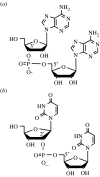Montmorillonite-catalysed formation of RNA oligomers: the possible role of catalysis in the origins of life
- PMID: 17008218
- PMCID: PMC1664692
- DOI: 10.1098/rstb.2006.1903
Montmorillonite-catalysed formation of RNA oligomers: the possible role of catalysis in the origins of life
Abstract
Large deposits of montmorillonite are present on the Earth today and it is believed to have been present at the time of the origin of life and has recently been detected on Mars. It is formed by aqueous weathering of volcanic ash. It catalyses the formation of oligomers of RNA that contain monomer units from 2 to 30-50. Oligomers of this length are formed because this catalyst controls the structure of the oligomers formed and does not generate all possible isomers. Evidence of sequence-, regio- and homochiral selectivity in these oligomers has been obtained. Postulates on the role of selective versus specific catalysts on the origins of life are discussed. An introduction to the origin of life is given with an emphasis on reaction conditions based on the recent data obtained from zircons 4.0-4.5Ga.
Figures








Similar articles
-
Montmorillonite, oligonucleotides, RNA and origin of life.Orig Life Evol Biosph. 2004 Dec;34(6):549-70. doi: 10.1023/b:orig.0000043130.49790.a7. Orig Life Evol Biosph. 2004. PMID: 15570708
-
Montmorillonite catalysis of 30-50 mer oligonucleotides: laboratory demonstration of potential steps in the origin of the RNA world.Orig Life Evol Biosph. 2002 Aug;32(4):311-32. doi: 10.1023/a:1020543312109. Orig Life Evol Biosph. 2002. PMID: 12458736
-
Clay catalyzed RNA synthesis under Martian conditions: Application for Mars return samples.Biochem Biophys Res Commun. 2015 Jun 26;462(2):99-104. doi: 10.1016/j.bbrc.2015.04.044. Epub 2015 Apr 16. Biochem Biophys Res Commun. 2015. PMID: 25888789
-
Bridging the prebiotic and RNA worlds: prebiotic RNA synthesis on clay.J Biomol Struct Dyn. 2000;17 Suppl 1:207-10. doi: 10.1080/07391102.2000.10506623. J Biomol Struct Dyn. 2000. PMID: 22607426 Review.
-
Walking over 4 Gya: Chemical Evolution from Photochemistry to Mineral and Organic Chemistries Leading to an RNA World.Orig Life Evol Biosph. 2017 Sep;47(3):281-296. doi: 10.1007/s11084-017-9537-2. Epub 2017 Apr 21. Orig Life Evol Biosph. 2017. PMID: 28432500 Review.
Cited by
-
Signal enhancement of abiotically-synthesized RNA oligonucleotides and other biopolymers using unmodified fused silica in MALDI-MS.J Am Soc Mass Spectrom. 2011 Jun;22(6):1100-4. doi: 10.1007/s13361-011-0113-0. Epub 2011 Apr 12. J Am Soc Mass Spectrom. 2011. PMID: 21953051
-
Prebiotic Peptide Bond Formation Through Amino Acid Phosphorylation. Insights from Quantum Chemical Simulations.Life (Basel). 2019 Sep 16;9(3):75. doi: 10.3390/life9030075. Life (Basel). 2019. PMID: 31527465 Free PMC article.
-
Bacterial Utilisation of Aliphatic Organics: Is the Dwarf Planet Ceres Habitable?Life (Basel). 2022 May 31;12(6):821. doi: 10.3390/life12060821. Life (Basel). 2022. PMID: 35743852 Free PMC article.
-
Neural network properties of hydrophilic polymers as a key for development of the general theory of evolution.R Soc Open Sci. 2025 Apr 23;12(4):242149. doi: 10.1098/rsos.242149. eCollection 2025 Apr. R Soc Open Sci. 2025. PMID: 40271142 Free PMC article. Review.
-
In silico ribozyme evolution in a metabolically coupled RNA population.Biol Direct. 2015 May 27;10:30. doi: 10.1186/s13062-015-0049-6. Biol Direct. 2015. PMID: 26014147 Free PMC article.
References
-
- Amelin Y. A tale of early Earth told in zircons. Science. 2005;310:1914–1915. - PubMed
-
- Ban N, Nissen P, Hansen J, Moore P.B, Seitz T.A. The complete atomic structure of the large ribosomal subunit at 2.4 Å resolution. Science. 2000;289:905–920. doi:10.1126/science.289.5481.905 - DOI - PubMed
-
- Banin A, Lawless J.G, Mazzurco J, Church F.M, Margulies L, Orenberg J.B. pH profile of the adsorption of nucleotides onto montmorillonite. Orig. Life Evol. Biosph. 1985;15:89–101. doi:10.1007/BF01809491 - DOI - PubMed
-
- Birdson P.K, Orgel L.E. Catalysis of accurate poly(C)-directed synthesis of 3′-5′-linked oligoadenylates by Zn2+ J. Mol. Biol. 1980;144:567–577. doi:10.1016/0022-2836(80)90337-X - DOI - PubMed
-
- Brandes J.A, Boctor N.Z, Cody G.D, Cooper B.A. Abiotic nitrogen reduction on the early Earth. Nature. 1998;395:365–367. doi:10.1038/26450 - DOI - PubMed
Additional references
-
- Banin A, Lawless J.G, Mazzurco J, Church F.M, Margulies L, Orenberg J.B. pH profile of the adsorption of nucleotides onto montmorillonite. Orig. Life Evol. Biosph. 1985;15:89–101. - PubMed
-
- Inoue T, Orgel L.E. Substituent control of the poly(C)-directed oligomerization of guanosine 5′-phosphorimidazolide. J. Am. Chem. Soc. 1981;103:7666–7667.
-
- Joshi, P. C., Pitsch, S. & Ferris, J. P. In press Selectivity of montmorillonite catalyzed prebiotic reactions of d, l-nucleotides. Orig. Life Evol. Biosph. - PubMed
Publication types
MeSH terms
Substances
LinkOut - more resources
Full Text Sources
Other Literature Sources
Research Materials
Miscellaneous

